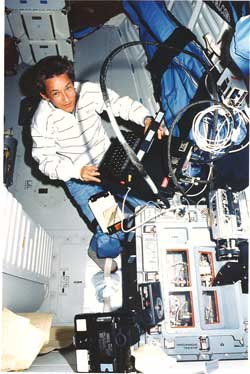Section navigation
 Dr. Mary Cleave
Dr. Mary Cleave
Have you ever considered a STEM career? STEM stands for science, technology, engineering, and math. Maybe you're interested in studying animals or you like working with numbers — or maybe you really want to travel into space. Mary Cleave, Ph.D., P.E., can tell you what that's like; she's been to space twice.
Dr. Cleave believes it's never too early to start exploring your interests and passions. Before she realized she wanted to look into a career as an astronaut, she thought she wanted to study plants. Check out Dr. Cleave's advice about pursuing a STEM career and what it was like to be one of the first American women in space.

You've gone on two missions to space. Can you tell us what it's like?
Both of my missions were on the space shuttle Atlantis. You train for at least a year with your crew before you fly, so you all get to know each other really well. The missions are scheduled very carefully, so no time is wasted, and you do a wide variety of activities. I was the flight engineer and robotic arm operator on my first flight. On my second flight, we gave Magellan, an unmanned vehicle that explored the planet Venus, a ride into space.

What's the coolest part about traveling in space?
Weighing nothing is great fun. So is going around the Earth every hour and a half at 25 times the speed of sound. You get a sunrise or a sunset every 45 minutes, and you go across the continental United States in about 7 and 1/2 minutes.

When did you decide you wanted to become an astronaut?
I was finishing my studies at Utah State University. NASA started advertising for scientists and engineers to go work in space on the space shuttle. It was before the Internet, so they had a poster up in the post office in Logan, Utah. It was on the wall next to the FBI 10 most wanted posters. When I found out that being an astronaut meant being able to fly T-38 jets, it sounded like the perfect job to me. I had never considered it before, because no women had ever been hired into NASA's Astronaut Corps — Astronaut Corps hires and trains astronauts for space missions. That started to change when a new law called Title IX was passed. That law states that no person can be discriminated against in education programs or activities that are funded by the government because of their gender. It was an exciting time; so many positions that had not been available to women were suddenly to open to us.

You're also an engineer. Can you tell us what it means to be an engineer?
Engineers use their scientific and mathematical knowledge and skills to find solutions that benefit our society. I was trained as a civil environmental engineer. This type of engineer might design water treatment plants that provide clean water and other systems that people need to stay safe and healthy. They work to understand how projects will affect the environment.

What's been the highlight of your career?
There have been a number of highlights in my career, not just one. Flying in the space shuttle, being the project manager on the first robotic spacecraft that regularly measured all the plants on Earth, and working on a variety of space science missions at NASA headquarters are all highlights of my career.

Did you face any challenges along the way, especially as a woman in a male-dominated field?
There were many challenges involved with being one of the first women to fly in space. For example, all of the crew equipment was designed for men, so we had to modify it so it would work for women. I was the smallest person in the Astronaut Corps, so I got to test systems to make sure they would work for small people.

What advice would you give to girls interested in STEM?
There are so many different possibilities in STEM fields, so take a wide look at all of them and try out the ones you find interesting. Once you learn the tools of STEM, like the laws of physics and how to solve math problems, you can spend time learning all about one subject, or you can move around and work in different areas of interest, so you never get bored.

Why do you think girls should consider pursuing careers in STEM?
Careers in STEM have so much variety and flexibility. STEM is under the control of the laws of physics. The laws of physics are rules that natural processes follow, like gravity. We can't change it or create it, but we can discover, study, and understand it. That makes it is easier to prove yourself in the STEM field. Plus, the STEM field pays well and there are a lot of jobs available, so you can choose where you live and what you work on.

Is there anything else you'd like to share?
Preparing for a career in STEM requires careful attention and time. You'll invest a lot of time in homework, but the hard work really pays off after you graduate from school. Your career lasts a lot longer than your years in school, so it is definitely worth working harder in school and following a career in STEM.
Starting to think about the future? Check out our information on STEM Careers and, for a little inspiration, visit our Women as Role Models page.
Content last reviewed September 10, 2015
Page last updated September 10, 2015








